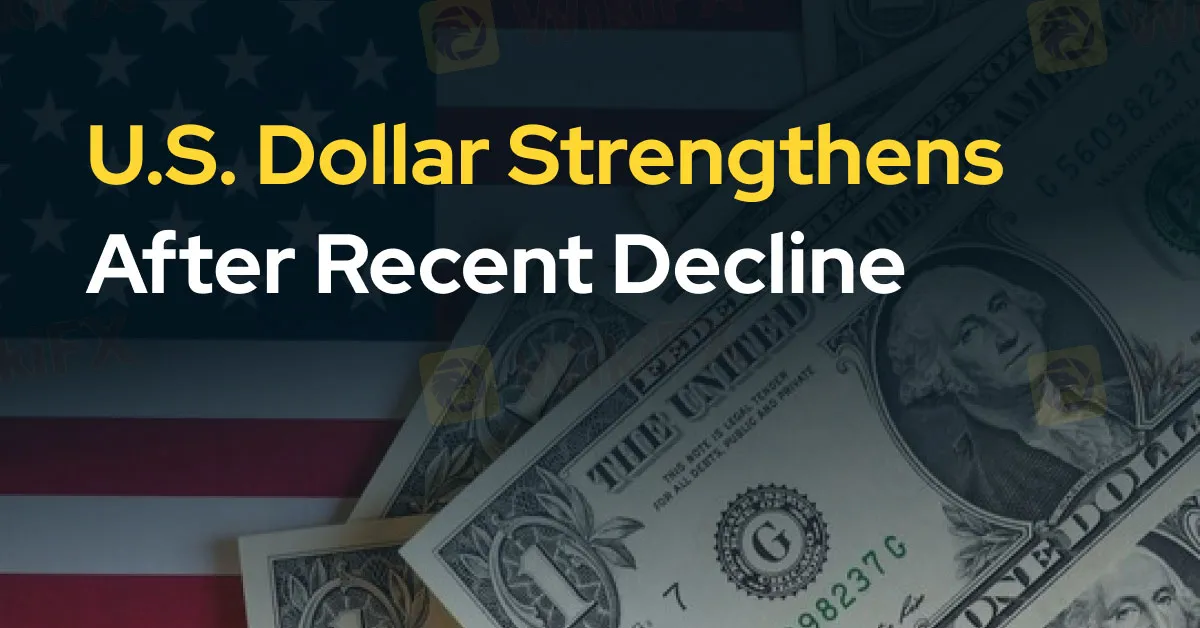简体中文
繁體中文
English
Pусский
日本語
ภาษาไทย
Tiếng Việt
Bahasa Indonesia
Español
हिन्दी
Filippiiniläinen
Français
Deutsch
Português
Türkçe
한국어
العربية
U.S. Dollar Strengthens After Recent Decline
Abstract:After experiencing a downward trend over the past several days, the U.S. dollar has regained some of its lost ground during trading on Thursday. The U.S. dollar index, a measure of the greenback's value against a basket of major currencies, is climbing 0.49 points or 0.5 percent to 101.53. This marks a significant recovery from its lowest levels in nearly eight months.

After experiencing a downward trend over the past several days, the U.S. dollar has regained some of its lost ground during trading on Thursday. The U.S. dollar index, a measure of the greenback's value against a basket of major currencies, is climbing 0.49 points or 0.5 percent to 101.53. This marks a significant recovery from its lowest levels in nearly eight months.
The dollar's performance against key currencies reflects this rebound. The greenback is now trading at 146.5 yen, up from the 145.21 yen it fetched at the close of New York trading on Wednesday. Similarly, against the euro, the dollar is valued at $1.1109, compared to $1.1124 the previous day.
Economic Concerns Influence Dollar Rebound
The rebound in the dollar's value may partly be attributed to ongoing economic concerns. A recent report from the U.S. Department of Labor showed a modest increase in initial jobless claims for the week ended August 17th. According to the report, jobless claims rose to 232,000, an increase of 4,000 from the previous week's revised level of 228,000. While economists had expected a slight rise to 230,000 from the 227,000 originally reported, the actual figures suggest a slightly higher level of unemployment claims than anticipated.
These economic indicators are crucial for traders and investors who are closely monitoring the health of the U.S. economy. The uptick in jobless claims may be a sign of a softening labor market, which could influence the Federal Reserve's monetary policy decisions in the coming months.
Focus on Jackson Hole Economic Symposium
Adding to the market's cautious optimism is the upcoming Kansas City Fed's Jackson Hole Economic Symposium, which begins later in the day. The annual event is highly anticipated by market participants, as it often provides critical insights into the Federal Reserve's policy direction.
Fed Chair Jerome Powell is scheduled to speak at the symposium on Friday, and his remarks are expected to provide further clarity on the outlook for interest rates. According to Adam Turnquist, Chief Technical Strategist for LPL Financial, “Powell is expected to lay the groundwork for the Fed's first rate cut in over four years.” Turnquist noted that signs of reduced pricing pressures and cooling economic growth could be enough for policymakers to start reducing the target rate.
However, the focus will not solely be on the potential rate cut in September. Investors will also be keen to hear more about the Fed's longer-term monetary policy plans. Powell's comments will be closely analyzed for any hints on how the central bank plans to navigate the balance between supporting economic growth and controlling inflation in the months ahead.
Conclusion
The recent strengthening of the U.S. dollar underscores the complex interplay of economic data and market expectations. As traders look ahead to the Jackson Hole Symposium and the potential policy shifts from the Federal Reserve, the dollar's trajectory will likely continue to be influenced by both domestic economic indicators and global market developments.

Disclaimer:
The views in this article only represent the author's personal views, and do not constitute investment advice on this platform. This platform does not guarantee the accuracy, completeness and timeliness of the information in the article, and will not be liable for any loss caused by the use of or reliance on the information in the article.
Read more

Malaysian-Thai Fraud Syndicate Dismantled, Millions in Losses Reported
The Royal Malaysia Police (PDRM) has received 26 reports concerning the Nicshare and CommonApps investment schemes, both linked to a major fraudulent syndicate led by a Malaysian citizen. The syndicate’s activities came to light following the arrest of its leader by Thai authorities on 16 December.

WikiFX Review: Is FxPro Reliable?
Founded in 2006, FxPro is a reputable UK-based broker, trading on various market instruments. In this article, we will help you find the answer to one question: Is FxPro reliable?

Geopolitical Events: What They Are & Their Impact?
You've heard many times that geopolitical events have a significant impact on the Forex market. But do you know what geopolitical events are and how they affect the FX market? Let us learn about it today.

Why Do You Feel Scared During Trade Execution?
Trade execution is a pivotal moment for traders. It is when analysis turns into action, and potential profits or losses become reality. However, for many traders, this moment is accompanied by fear. Why does this happen, and how can you address it?
WikiFX Broker
Latest News
Geopolitical Events: What They Are & Their Impact?
Top 10 Trading Indicators Every Forex Trader Should Know
ASIC Sues Binance Australia Derivatives for Misclassifying Retail Clients
WikiFX Review: Is FxPro Reliable?
Malaysian-Thai Fraud Syndicate Dismantled, Millions in Losses Reported
Trading frauds topped the list of scams in India- Report Reveals
Why Do You Feel Scared During Trade Execution?
WikiFX Review: Something You Need to Know About Markets4you
Revolut Leads UK Neobanks in the Digital Banking Revolution
Fusion Markets: Safe Choice or Scam to Avoid?
Currency Calculator


